1 - 9 of 9 records
Collection of poetic excerpts, calligraphic studies and seals.

Description: An intriguing compilation of calligraphic excerpts, together with annotations and quotations from the Qur'an and from poetic treatise, most probably compiled for personal use and reference by a student of calligraphy. The volume also features a vast quantity of seal impressions; each of these carefully pasted onto hand-painted card cut-out to the shape of each individual seal. These could either be a personal collection, for record-keeping or reference, or there is a possibility that the collector was an engraver of seals and kept a record of their work.nnSingle volume, decorated manuscript on paper with some gilt additions, predominantly in Arabic, 88 leaves (8 of these blanks across different sections of the volume), 200 by 120 mm; mixed columns and formats throughout, mostly containing Qur'anic extracts, quotes of lyrical poetry and personal annotations and marginalia, many examples of varying calligraphic styles demonstrated throughout, some leaves loose and a few scattered light stains; contemporary hand-painted leather boards with flap, covers ruled in gilt, marbled paper doublures, spine cracked and worn, extremities rubbed.nnFull pdf available, https://dl.mospace.umsystem.edu/mu/islandora/object/mu%3A448404/datastream/PDF/viewnnImage capture notes:nSome text in the gutter was blocked/cut off when captured. nTwo of the leaves at the end of the book are attached about halfway up the page, blocking text int the attached area from being captured.
Resource Type: Text
JM-147: Swimming the Hellespont
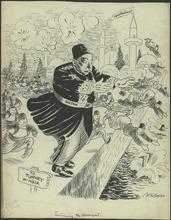
Description: This cartoon depicts the 1913 Ottoman coup d'état, in which the Committee of Union and Progress overthrew the monarchy of the Sultan. The Committee of Union and Progress was a political group, which had aligned itself with the Young Turks. The young Turks were a group that sought to turn the Ottoman Empire into a constitutional government. A statesman in Constantinople, Kamil Pasha had been working to eliminate the Committee of Union and Progress. In response to this, the Committee launched a coup, and quickly ousted the Ottoman government. The Hellespont, now referred to as the Dardanelles, was a waterway near Constantinople. (Summary created by Mary Delano, MU History Intern, Spring 2018)
Member of: McCutcheon Editorial Cartoons - ALL (Collection)
Resource Type: Still Image
JM-146: The troubles of Turkey

Description: This cartoon shows the defeat of the Ottoman Empire in two separate conflicts. The top panel, shows the Ottomans surrendering the province of Tripolitania after Italy captured it in the Italo-Turkish War. The Italo-Turkish War occurred from September 29, 1911, to October 18, 1912. The bottom panel shows the Ottoman's final defeat at Khanhadjigogo in the First Balkan War. The First Balkan War occurred from October of 1912 to May of 1913, and was fought between the Ottoman Empire and the Balkan League. The Balkan League was a collection of the states of Greece, Bulgaria, Serbia and Montenegro. The Balkan League was formed to increase military strength, and to promote the mutual interest of all four nations. The Balkan League had seen the Italo-Turkish War had weakened the Ottoman Empire, and quickly attacked to take advantage of their position. (Summary created by Mary Delano, MU History Intern, Spring 2018)
Member of: McCutcheon Editorial Cartoons - ALL (Collection)
Resource Type: Still Image
JM-164: Will there be enough to go round?
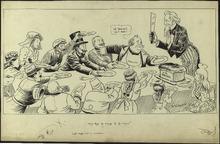
Description: This cartoon depicts Uncle Sam trying to divide "U.S. Bread" among various nations. In 1915, World War I was being fought in Europe, but the United States was maintaining a neutral position. Despite its neutrality, the United States supplied resources and arms to nations during the war. All of the countries sitting at the table are nations who lobbied for resources from the United States during the war. England is attempting to block Germany's chance of receiving resources from Uncle Sam. This is representative the attempts of the British government to limit the United States aid to Allied Powers, most often England. The United States is also sitting at the table, looking worried about sharing the beard with other nations. The United States distributing more resources than it could afford was a fear for many Americans in the 1910s. (Summary created by Mary Delano, MU History Intern, Spring 2018)
Member of: McCutcheon Editorial Cartoons - ALL (Collection)
Resource Type: Still Image
JM-216: And so they may go to war about it
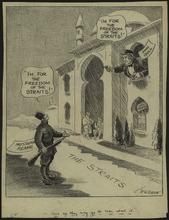
Description: Editorial cartoon depicts John Bull speaking to Mustapha Kemal from window of building labeled "Constantinope." Both declare that they are for the freedom of the Turkish straits.
Member of: McCutcheon Editorial Cartoons - ALL (Collection)
Resource Type: Still Image
JM-218: The Turkish victory

Description: Editorial cartoon depicting the Turkish Victory of 1922, when the Turkish army won the Battle of the Commander-in-Chief against the Greek army on August 30.
Member of: McCutcheon Editorial Cartoons - ALL (Collection)
Resource Type: Still Image
The Turkish Empire
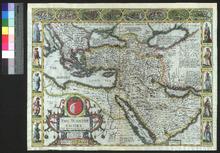
Description: On verso: Text: The Description of the Turkish Empire
Member of: Venable Maps
Resource Type: cartographic
Turcici Imperii Descriptio
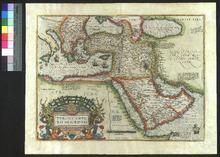
Description: Appeared in Ortelius' Theatrum Orbis Terrarum (1570). The cartouche was altered in 1579. Dutch editions of Theatrum Orbis Terrarum with the original plate were printed in 1571 and 1573.,On verso: Text: Turckyen
Member of: Venable Maps
Resource Type: cartographic
Turcicum Imperium
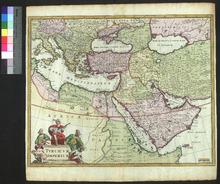
Description: Second state of the map; the earlier state included L'Huilier's credit in the lower right border.,On verso: Blank
Member of: Venable Maps
Resource Type: cartographic